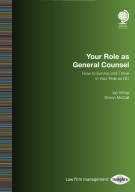Linking: looking past Svensson
02 June 2014

Author bio coming soon

Author bio coming soon
Copyright experts Ben Allgrove and Iona Silverman bring you up to date on the latest case law on linking.
With a number of pending cases before the European Court of Justice (ECJ), and its recent decision in Svensson and its decision in Meltwater hotly anticipated on June 5, we thought this would be a good time to round up the case law on linking and ask whether the ECJ has resolved this particular quirk of the application of copyright online.
We begin with Svensson, a case which was brought by a number of Swedish journalists against a media monitoring organisation, Retriever. Retriever provided links to websites hosting content which had been written by the journalists. The journalists argued that the provision of these links constituted a communication to the public, and thus infringed Article 3 of the EU Information Society Directive. The Swedish court referred four questions to the ECJ, which held as follows:
- The provision of a link constitutes an act of communication and the links were aimed at “an indeterminate and fairly large number of recipients”; therefore, the communication was to the public. However, the links did not make the works available to a “new public” that was not taken into account at the point of the initial communication, because all internet users had free access to the articles prior to provision of the links as they could directly access the original site. Therefore, there was no infringement under Article 3.
- The same logic applied to framing.
- If a link makes it possible for users to circumvent restrictions put in place on the referred website which seek to restrict public access and, without the link, users would be unable to access the works, then those users will be deemed to be a ‘new public’ and provision of the link will infringe.
- Unsurprisingly, EU member states cannot confer wider protection than that set out in Article 3(1) of the Information Society Directive.
In short, provision of a link does not constitute a communication to the public, as long as the content subject to the link is already freely accessible online.
Contrast this with the position in ITV v TVCatchUp, where the ECJ held that by capturing television broadcasts (which were freely available to anyone with a television licence) and retransmitting the content over the Internet, TVCatchUp did communicate broadcast works to the public. The difference seems to be that the broadcasters had never intended their content to be viewed online, whereas the journalists in Svensson plainly always intended their articles to be viewed on the websites which they had authorised.
Has the ECJ fully answered the question of how copyright law applies to linking?
No - although the ECJ’s decision in Svensson is helpful, some questions are still outstanding. Helpfully, some cases in the pipeline should assist in answering them.
Bestwater should answer the question of whether embedding videos is infringing or whether the ECJ will take the same approach that it took to framing when considering linking in Svensson. And in C More Entertainment the ECJ has been asked to consider whether the provision of links to infringing content is a communication to the public (in contrast to Svensson, where the links were to authorised content).
What about the reproduction right?
The ECJ found in Infopaq that 11 words could be sufficiently original to attract copyright. This means that a link which contains an original work (eg, a headline or title) can infringe. This may sound bizarre to some, but the Court of Appeal of England and Wales expressly found in NLA v PRCA (Meltwater) that hyperlinked headlines and URLs can themselves be protected as independent works if sufficiently original. So linkers, beware: while provision of a link to freely accessible, legitimate content may not infringe the communication to the public right, if the link contains a title it could infringe the reproduction right if that title is deemed to be the author's own intellectual creation.
The question of headlines and snippets was not addressed in Svensson. In addition, various local laws have tried to impose a tax on online news aggregation services - for example, the German ancillary copyright for press publishers or the recent draft bill in Spain which seeks to amend the Copyright Act (1/1996) and the Civil Procedure Act (1/2000).
Further, in Meltwater, the Newspaper Licensing Agency argued that users who clicked on links were themselves infringing the reproduction right by making copies of content on their computer screens and hard drives. Meltwater argued that these copies were temporary for the purpose of Article 5(1) of the Information Society Directive, and that there was therefore no infringement. The ECJ’s decision on this point is eagerly anticipated, as it will determine whether the reproduction right offers a viable alternative to rights holders when it comes to protecting their works from linking.
And what about the database right?
Though this is a copyright blog post, we had to mention the recent case of Innoweb, in which the ECJ held that a meta-search engine (a search engine which calls on other search engines to return its results) infringed the database right.
The facts of this case were relatively narrow, leading the court to find that a website re-utilises the whole or a substantial part of the contents of a database, and therefore infringes Article 7 of the EU Database Directive, if it.
- provides the end user with a search form which essentially offers the same range of functionality as the search form on the database site;
- “translates” queries from end users into the search engine for the database site “in real time” so that all of the information on that database is searched through; and
- presents the results to the end user using the format of its own website, grouping duplications into a single block item, but in an order which reflects the criteria comparable to those used by the search engine of the database site concerned.
The ECJ did not deal with the issue raised under Article 7(5) (repeated and systematic reutilisation of insubstantial parts), as it found that a substantial part of the contents of the database had been reutilised by the meta search engine because it made the entire contents of the relevant database site available to end users as if a query were entered directly into the target website’s database.
Given the narrow facts of this case, it would not be fair to say that all meta-search engines infringe the database right; and indeed the court was careful to distinguish between meta-search engines and traditional search engines. However, as the answers to the copyright questions become clearer, we can expect to see rights holders bring more database rights cases seeking to push the boundaries of what is permissible on the Internet.
What can we take from these cases?
The courts continue to enlighten us as to how the communication to the public right is to be applied online. The ECJ has made a start in assisting rights holders and users alike to determine what is and is not permitted, and t cases in the pipeline should hopefully answer the outstanding issues. In summary:
- linking to non-infringing works which are freely accessible online does not infringe the communication to the public right;
- using links to circumvent technical protection measures which restrict access to websites does infringe the communication to the public right;
- including content within a link may infringe the reproduction right if that content is the author’s own intellectual creation;
- it is still unclear whether it is permissible to:
- link to works where that infringes website terms and conditions;
- link to infringing works; or
- embed videos; and
- it is also unclear:
- how far the database right will extend; and
- whether the reproduction right can be used to circumvent Svensson or whether local copies made when browsing are temporary.
Ben Allgrove is a partner in Baker & McKenzie LLP’s IP and IT/communications practice groups in London, where he advises on contentious and non-contentious media, technology and intellectual property.
Iona Silverman is an associate at Baker & McKenzie LLP. She advises on a broad range of IP matters, with a particular interest in copyright law.













Any comments - send us an email